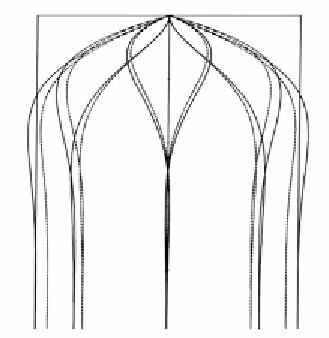Geoscience Reference
In-Depth Information
one-dimensional schematisation is valid, because the wave length is in both cases
much larger than the consolidating zone. The effective stress
'
can be treated in
the same way. The amplitude is the counterpart of
u
because at any moment their
sum is equal to the loading amplitude
a
0
. Hence. the effective stress amplitude
'
can be obtained from the graph of Fig 16.4b. In a zone beyond
z
= 2.06
) the
induced effective stress becomes negative (tensile). Because of hydrostatic stress
(gravity is not included in this analysis) tensile stresses may not occur, but lower
effective stress does occur.
(
c
v
/
2
1
u/
0
+1
1
u/
0
+1
1
t/T
0.5 0.4 0.6 0.3 0.7 0.2 0.8 0.1 0.9 0.0
2
layer 1
layer 2
3
G
dashed line
k
1
=10
-2
m/s
k
2
=10
-4
m/s
c
v
1
=0.5 m
2
/s
c
v
2
=0.05
solid line
k
1
=10
-3
m/s
k
2
=10
-4
m/s
c
v
1
=0.5 m
2
/s
c
v
2
=0.05
z/D
4
a = 0.9
a = 1.0
2
(a) cyclic pore pressures uniform seabed (b) cyclic pore pressures layered seabed
Figure 16.5
This particular example shows three typical effects of cyclic consolidation: (1)
the maximum pore pressure at some moments may exceed the maximum total
loading, (2) the generated effective stresses may decrease (become zero), and (3)
there is a negative delay in the response. Moreover, these phenomena may take
place in a relatively small zone near the border, which with regard to the
wavelength supports the validity of the one-dimensional approach.
Next, consider a stratified subsoil, i.e. a two-layer system. The upper layer is
defined in the range 0 <
z
<
D
, and the second layer in the range
z
>
D
. At the
boundary
z
= 0 a cyclic loading is imposed, according to Fig 16.4a. The elaboration
is tedious and not presented here. In Fig 16.5b the solution for two situations is
presented (incompressible pore water). Note, that the maximum pore pressure
occurs at the layer separation and is in the order of 1.11
0
, exceeding the loading
by 11%.
The gradient
u
,z
in the second layer at the interface is of particular interest. It is
expressed by
(
A
2
+
B
2
)
u
,z
=
(
2
/c
v
2
) cos(
2
t
+
/
4) /
(16.11)
0
A
= cos(
D
(
2
/2c
v
1
))(cosh(
D
(
2
/
2
c
v
1
) +
?
sinh(
D
(
2
/
2
c
v
1
))













Search WWH ::

Custom Search